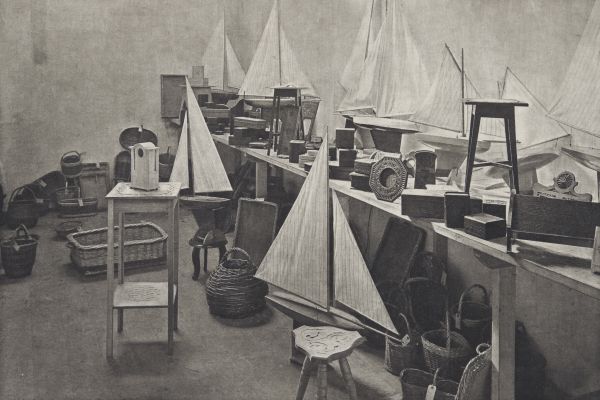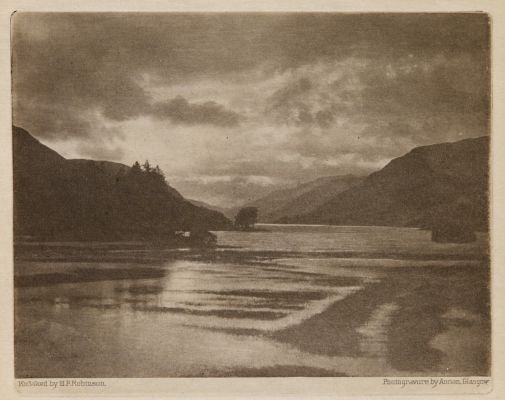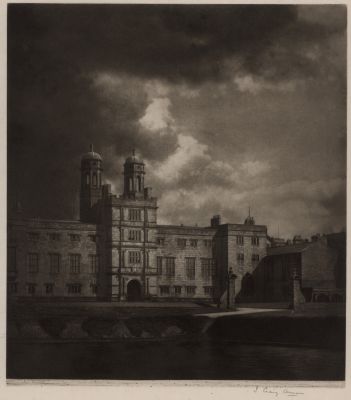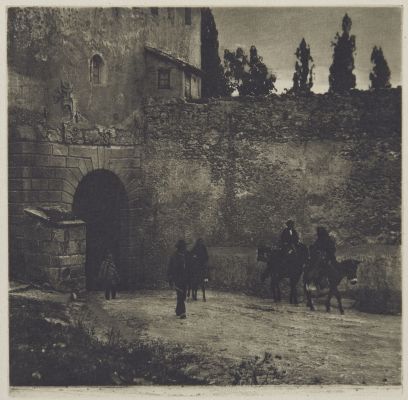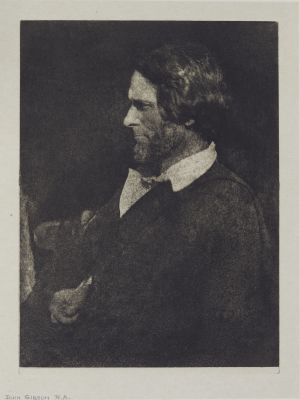
Title
Venice from LidoArtist
Annan, James Craig (Scottish, 1864-1946)Key FigurePublication
Venice and Lombardy (proof)Date
1896Process
Photogravure (tissue)Atelier
James Craig AnnanImage Size
9.5 x 15 cm
David Young Cameron described James Craig Annan’s photogravure of Venice as a dream in the softest tones dedicated in loving homage to the Bride of the Sea lying enchanted and far away across the long low lines of grey lagoons. Annan’s print was a homage to James McNeill Whistler whose well-known ‘Venice Set’ etchings may have inspired the 1894 trip to Venice Annan made with etcher friend Cameron from which these works arise. Whistler’s atmospheric etchings and nocturnes inspired Annan, who strived to infused atmospheric and tonal aesthetics into his photography. Annan was fascinated by photogravure’s ability to render mood and atmosphere, essential qualities in Whistler’s work. In judging an ordinary photograph one of the chief points to be considered is, to what extent the feeling of atmosphere has been introduced into it. [1]
In 1894 Annan traveled in Genoa and Venice with the artist and etcher, D.Y. Cameron. He remarked that: ‘It has been when I have associated with artists that I have made my most successful pictures’. In this work, Annan has framed the posts in the water against the far towers and then waited until the oar of the drifting gondola has cut the skyline of the city at exactly the correct point to balance this striking abstract composition.
Since the early nineties James Craig Annan had been one of the chief forces in the development of pictorial photography. This portfolio of prints is his masterpiece. Limited to an edition of 75, the eleven plates include some of Annan’s most sophisticated and celebrated early work. The small photogravures masterfully etched and printed by Annan himself on Japan tissue and individually signed, explore for the first time the instantaneous moments accessible only to the camera combined with the control, art and craft of traditional etching. The tension between photography emulating painting and a truthful photography able to represent a new art form is clearly visible in Venice and Lombardy and reveals Annan’s ability to articulate the most advanced issues of his time. The portfolio, according to Ken Jacobson, contains signed, tiny, gem-like photogravures that might be seen as the precursor for the style of Camera Work – Stieglitz’s widely praised journal, vehicle of modern photography and photogravure tour-de-force. Stieglitz greatly admired Annan and was certainly influenced by this work.
Reproduced / Exhibited
Jacobi, Carol, and Hope Kingsley. Painting with Light: Art and Photography from the Pre-Raphaelites to the Modern Age, 2016. pl. 85
Morrison-Low, A D, Julie Lawson, and Ray McKenzie. Photography 1900: The Edinburgh Symposium Edinburgh: National Museums of Scotland and the National Galleries of Scotland, 1994. fig. 22.
Stevenson, Sara, and Duncan Forbes. A Companion Guide to Photography in the National Galleries of Scotland. Edinburgh: National Galleries of Scotland, 2009. p. 118
Buchanan, William, and J C. Annan. The Art of the Photographer: J. Craig Annan, 1864-1946. Edinburgh: National Galleries of Scotland, 1992. plate 6.
Naef, Weston J. The Collection of Alfred Stieglitz: Fifty Pioneers of Modern Photography. New York: Viking Press, 1978. no. 26.
References
[1] Bologna, Gabriella, The Aesthetics of British Photography. A Case Study: James Craig Annan’s Portfolio Venice and Lombardy in Anon. 2013. Aesthetic Lives : ‘New Experiences New Subjects of Poetry New Forms of Art’. High Wycombe Bucks England: Rivendale Press
Jacobson Ken. 2007. Odalisques & Arabesques : Orientalist Photography 1839-1925. London: Quaritch.
